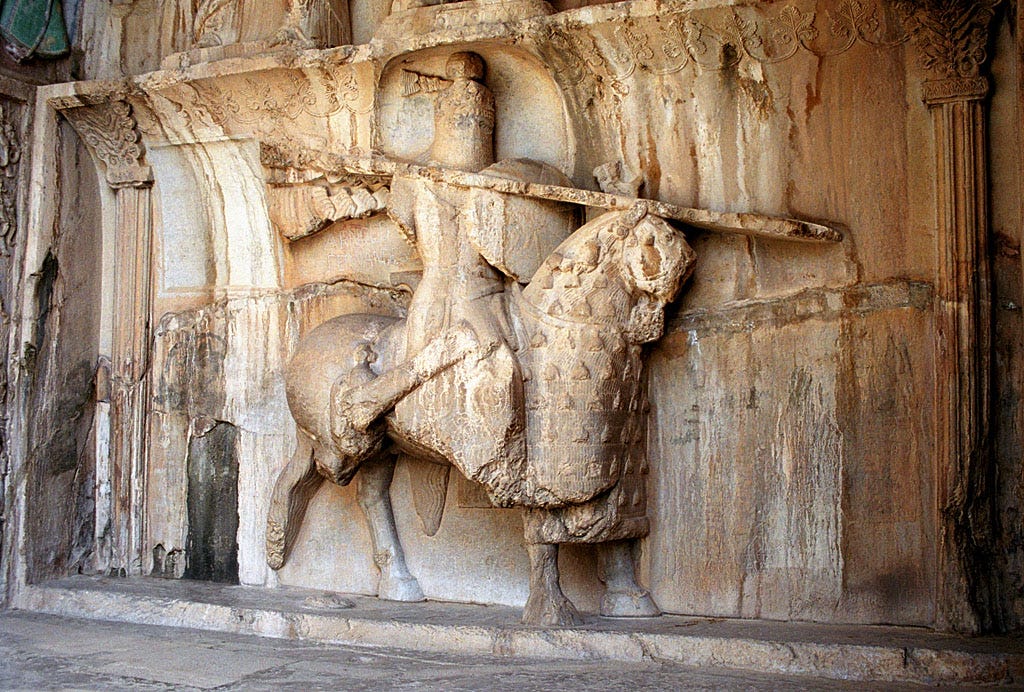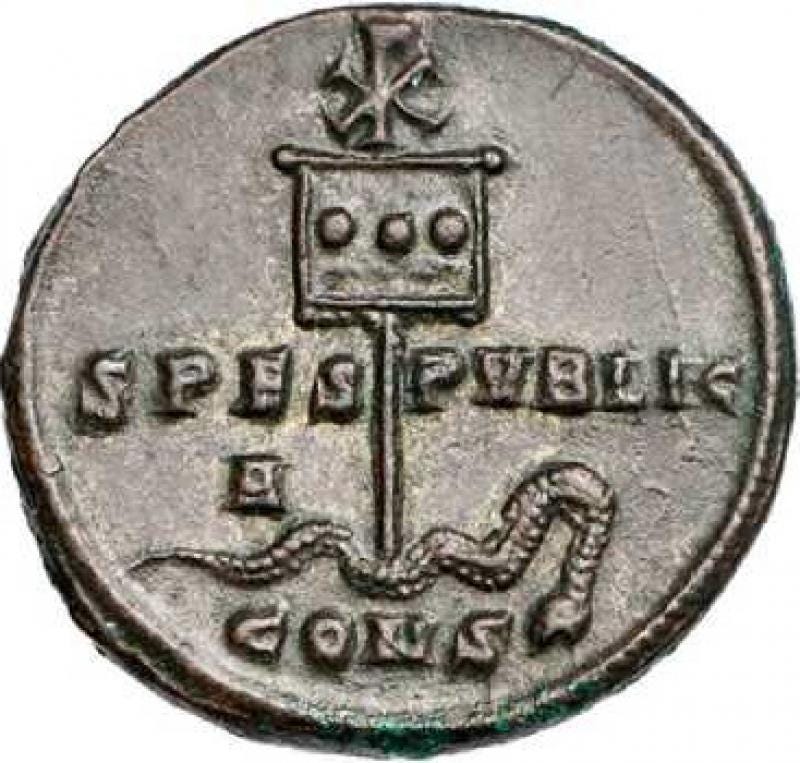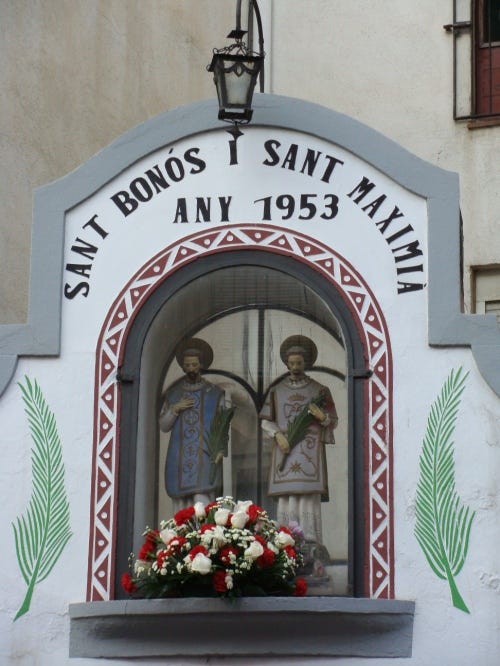Join me today to meet two unbreakable soldier saints and a doomed prince.

Names: Maximian & Bonosus
Lives: Died 363 AD
Status: Saints
Feast: August 21
You can listen to this as a podcast on Apple Podcasts, Pocket Casts, Spotify or right here on Substack. If you prefer video, you can also follow on YouTube and Odysee (unfortunately, videos on Odysee may be slower to update).
The invasion had been a disaster. The Emperor Julian, whom we remember as Julian the Apostate, was dead. His plan to conquer Persia and use the glory of that victory to turn Rome back to the old pagan ways had failed. Now the leaderless and outnumbered Roman army was deep in the territory of their Sassanid Persian enemies. The situation was so bad that many of the powerful men in the army didn’t even want the title of emperor.
Finally, they found someone willing to be emperor: Jovian, formerly one of Julian’s senior officers and elite bodyguards. And so, on the long march out of Persia, Jovian worked things out with the Persian King of Kings, Shapur II. Shapur wanted many things in return for letting the Romans go home. One of the things he asked from Jovian was a betrayal.
When a foreigner was accepted in Rome as a suppliant seeking sanctuary, the Romans regarded it as a sacred duty to never abandon their guest. But the new emperor Jovian was desperate. When Shapur II demanded that he hand over the suppliant Prince Hormisdas, Jovian agreed. It was a betrayal so shameful, so shocking to the Roman mindset, that historian David Woods has argued that commentators of the time wrote around the incident, not willing to admit even to themselves that Rome had been reduced to this.
Hormisdas, the man who had been betrayed, was the brother of the Persian king. He had been a key part of Julian’s strategy going into Persia. Hormisdas could speak to Persian city leaders and negotiate their surrender. He was also a talented officer. Shapur had wanted Hormisdas dead from the start, and had sent the Surena, that is, the patriarch of one of Persia’s powerful clans, to ambush Hormisdas as he crossed the Euphrates with a detachment of heavy cavalry. It might have worked, but Hormisdas had that most important quality in a commander: luck. The Euphrates was flooded, and when Hormisdas moved upstream to find another place to cross, he ran into the Surena and his men, giving him the element of surprise as he routed the would-be ambushers.
Hormisdas hadn’t just been helpful on this expedition. For years he had been a companion of Julian’s predecessor, the Emperor Constantius II. And over time, the Romans had gotten used to Hormisdas, acquiring a grudging respect for the Persian warrior whose dry sense of humour could cut as deep as his sword.
As it happens, the story of the witty, worldly, doomed Persian prince is tangled up with the story of today’s manly saints, Maximian and Bonosus. The thing that brought them together was the Emperor Julian’s grand plan to attack Persia. Now there were many reasons that Rome had tried and failed to conquer Persia so many times before. But part of it had to do with tactics, and that part went way back, back to when Rome was a republic and the Persians were called Parthians. The backbone of the Roman military was the heavy infantry unit, the legionary. Legionaries could engage at medium range with throwing or stabbing spears, and up close with swords. But the Persians used a kind of unit that made life difficult for the legionaries: the mounted archer. Persian archers would ride around the field firing arrow after arrow, even shooting while they were retreating, the so-called Parthian shot. Now, since neither the Romans nor the Persians had developed the stirrup, mounted troops did not have the striking power of infantry. But the Persian horse archers could wear down the legionaries with arrows. Then, when the legions were worn out, it was time for a charge by the other part of the Persian military, the heavy cavalry.
Rome had been working on ways to counter Persian tactics. The Sixth Legion, the legion of Maximian and Bonosus, was a part of this military experiment. These legionaries had received additional training as darters. Behind their red shields, each legionary held a number of lead-weighted darts, shaped a little like what you’d toss at a dartboard. Only these darts were much larger, big enough to kill a man or even to cripple one of the fast-moving Persian horses. The idea was that when the horse archers came in, the legionaries could fire back, knock many of them off their horses, then advance to finish them off.
Rome was also developing its cavalry. There had always been riders, but now Rome wanted to match the Persian heavy cavalry. Hormisdas had grown up fighting in armour on horseback, and in time he came to lead a detachment of heavily armoured riders.

Hormisdas had fled from Persia decades before. The Romans were glad to accept him as a suppliant, not least because they recognized his potential value. There might come a time, after all, when they were in a position to substitute him for the current king of Persia. It wasn’t a job that just anyone could do. A Persian king needed to be a member of the House of Sasan and a fierce man, a warrior and a hunter. Hormisdas checked all the boxes. It was just a bonus that he could also train the Roman heavy cavalry.
And so, under the Emperor Julian’s predecessor Constantius II, Hormisdas had fought alongside the Romans. That was how he came to accompany Constantius II to the city of Rome. It would be Constantius II’s first visit to the city of Rome itself - it had been a long time since the emperors were ethnic Romans. Constantius gawped at the beautiful architecture, stopping in front of a statue of the long gone emperor Trajan on his horse. Constantius told Hormisdas he would like a horse like that too. Looking around at the beautiful marble buildings surrounding the statue, Hormisdas dryly remarked that such a horse required better stables than he figured Constantius could provide. As for his own thoughts on Rome, Hormisdas kept them to himself. The best part of the trip, he said, was learning that even in Rome, men were mortal.

It was also on that trip to the city of Rome that Hormisdas revealed his growing religious awareness. Hormisdas and his men had played such an important role in one of the emperor’s victories that they were given the honour of preparing placards to show the Romans what had happened. Constantius II expected to be drawn as a conqueror, with Hormisdas playing an important role too. Instead, Hormisdas depicted them all as ordinary mortals, and had the Hand of God turning back the barbarians. The paintings caused a minor scandal, but Romans wrote it off as just another odd Persian quirk.
A few years later, Constantius II died. His son Julian came to power. Julian shocked the empire with his reversion to paganism. And then Julian began planning what was supposed to be his legacy project, his Persian expedition. And it was then that the story of Hormisdas and of Maximian and Bonosus came together. The Sixth Legion were probably running cavalry drills with Hormisdas’ heavy cavalry. It was the year 363 AD. Although none of the men knew it, they had entered the final year of their lives.
For Maximian and Bonosus, the problems began because of their standards. Legionaries went into battle carrying standards. For a long time, those standards had been golden eagles. Now these eagles were not mere symbols, they were military gods, gods who warded the legions as they marched out beyond the domain of the gods of Rome. But that had changed under the first Christian emperor, the Emperor Julian’s uncle, who received a vision inviting him to conquer under a new symbol. This was the labarum, a symbol that looks like an X drawn over a capital letter P. The letters are the Greek chi and rho, the first two letters in the word Christos. Now the Sixth Legion had adopted the labarum as their standard.

If he defeated the Persians, the Emperor Julian could hardly have his darters showing off the symbols of Christianity. Julian wanted the legion to change their standards, sending his own nephew to oversee the process. But the Sixth Legion, speaking through their representatives Maximian and Bonosus, refused.
The emperor’s nephew declared that this was a problem of military discipline. The solution was the same that it always was: flogging. He had Maximian and Bonosus stripped from the waist up and tied in place, as one of his men beat them with a lead-tipped whip. Gradually, though, the emperor’s nephew noticed something strange. Maximian and Bonosus weren’t suffering. They weren’t even bothered. God had given them that strange grace that sometimes seems to pass to martyrs, the grace to endure torture without pain.
The emperor’s nephew was not amused. He screamed that he had other ways of making Maximian and Bonosus change their minds. He ordered a caldron of pitch to be boiled, intending on dunking the two officers into the boiling liquid. But when they were forced into the caldron, again Maximian and Bonosus seemed undisturbed. Someone checked, and the pitch wasn’t even uncomfortably hot.
This was Christian sorcery, the emperor’s nephew told everybody. He reassured the watching soldiers of the Sixth Legion that pagan priests could do the same thing. He had his priests heat up the caldron of pitch, then step into it - only when they did it, they were scalded by the boiling liquid.
As you read the early account of the martyrdom of Maximian and Bonosus, it’s hard not to start chuckling. It’s strange to think of the story as a comedy, since at the end Maximian and Bonosus are executed. They are beheaded. What’s funny is the story of the two indestructible soldiers cheerfully going from one ineffective torture to the next as the emperor’s nephew plucks at his beard in frustration. The emperor’s nephew tries to burn them with quicklime but it won’t work. He tries to starve them and get them to eat bread consecrated to idols. The Christians simply fail to get hungry. By the end of the story the emperor’s nephew is so demoralized he just tells Maximian and Bonosus about things he’s thought of that he could do. He could have them thrown to wild beasts! He could put them into an oven! Maximian and Bonosus calmly agree. But they point out that what would happen as a result would be entirely up to God. And the emperor’s nephew is so totally demoralized that doesn’t even have the energy to argue the point.

Often in a comedy there is a character who plays the role of straight man. He’s the only one who sees what’s going on and reacts like the audience would react, and because of that he grounds the story. There is a straight man in the outrageous story of the martyrdom of Maximian and Bonosus, and it is none other the doomed prince, Hormsidas. As the emperor’s nephew schemes to find ever more elaborate torture scenarios, and as Maximian and Bonosus cheerfully remain unhurt, Hormisdas seems to be the only one to appreciate that they are surrounded by wonders. He visits Maximian and Bonosus in prison. In a few days, they will be beheaded. In a few months, Hormisdas will be given over to the Persians for torture and death. But at this moment, no one is sure what will happen next. We might expect a witty one-liner from the Persian prince. But instead, he says the right thing, the really important thing:
“Pray to the Lord for me, a sinner,” says Hormisdas to Maximian and Bonosus, “that I too may be saved.”
If you enjoy the Manly Saints Project, please consider signing up for a subscription on Substack, or click here or on the logo below to buy me a beer.






Nice post, thank you. But note that Constantius II was Julian's cousin who *murdered* Julian's father as well his some of his brothers and a bunch of his other relatives. He kept Julian and his half-brother Gallus alive because they were too young and the time and not considered a threat. Julian lived his life under a cloud of wondering whether Constantius II would eventually execute him too, and he did eventually execute Gallus. Constantius II and Julian had just begun a civil war when Constantius II suddenly died....